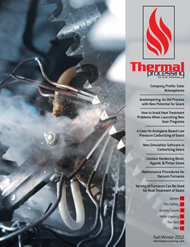When and how does a heat treater determine whether to purchase new equipment or rebuild an old furnace?
Several years ago I participated in a Heat Treating Society effort entitled Vision 2020 to set a course to identify areas of development critical to ensure the health of the metallurgical and heat treating industries. Genre such as high temperature furnace alloys, elevated temperature carburizing steels, more energy efficient furnace insulation, and heating systems are just a few areas of interest to receive attention. As a furnace guy, my interest is furnace and process development. How’s it going? Well, in a phrase: sunny, windy, and rainy. Some days it feels like yea, we can see the future so clearly while other days we ask: Are we stuck in the mud or what?
That observation may seem to discount our own efforts, but you have to understand the heat-treating industry: no one in their right mind would want to heat treat anything. Why? It’s that old “scorch & warp” sentiment. And here we are still after millennia, heating and quenching steel. Sure, we’re Sure we’re not embedding gears in charcoal any longer to add carbon, and we’re not forging hand tools to move parts from furnace to quench. But we can now quench in helium. That’s worth something, isn’t it? If it were eeasy, we would have found the solution a long time ago.
It’s a struggle no doubt, but why is it taking so long? Because we love it. For me it’s like reading a can’t-put-it-down book; I don’t want it to end. It’s a contradiction in terms, the effort is never ending but we must get there somehow.
The heat treat furnace industry I believe is very similar to the “garage sale” mentality: everyone loves a bargain. So, too, when it comes to heat treating. Heat treat furnaces are like when you’re Driving through the countryside, you see a farmhouse with a dozen rebuilt lawn mowers for sale. Furnaces, like lawn mowers, have nine lives.
If this preamble sounds depressing, don’t worry. For us, rebuilding furnaces is a good business. When the economy is struggling manufacturers try to save money by rebuilding furnaces opposed to purchasing new equipment. So that begs the question: When and/or how does a heat treater determine which approach makes more economic sense? To help make that decision here’s ten factors to consider:
- The type of furnace you need or already have.
- The age of the furnace.
- Furnaces built prior to 1979 likely have asbestos is wrapped ducts or around hot pipes.
- Furnaces built prior to 1979 likely have 100 percent relay logic in the control cabinet.
- These furnaces have old burner designs that, at best, achieve 50 percent heating efficiency.
- You’re probably still carburizing at 1650ºF [899ºC].
- You go through several oxygen probes a year.
- You still have the old infrared gas analyzers that you continuously zero and span.
- You are still replacing furnace radiant tubes frequently.
- Finally, nothing is working; your case depths are shallow, your furnace is a soot machine and maintenance is ready to walk out the door.
Is this what’s bothering you, Bunkie? Here are some answers:
- There are two types of furnaces: batch and continuous. Some continuous furnaces require frequent part replacements such as mesh belts, which last maybe 18 months, 24 months if you’re really lucky. Cast-link belts last much longer for reasons covered in previous columns. Pit furnace fixtures require frequent replacement (once a year is average). The retort maybe two or three years.
- Furnaces manufactured decades ago, like automobiles, were made from thicker steel plate, so the basic structure can last for several decades. The location has an impact on steel, for atmospheric issues like salt air. Refractory, however, if [IFB] insulation fire brick, will usually last eight to ten years with a few pointers along the way. A ceramic fiber blanket can withstand frequent temperature heat and cool swings, but when used in carburizing atmospheres will require replacement in, say, five years.
- Many times, instead of paying for the cost and liability associated with asbestos removal, the entire furnace is scrapped. This has occurred even with large pusher furnaces.
- Relay logic is still used today, primarily because of insurance requirements like Federal Mutual [FM] or Industrial Risk Insurers [IRI] where heating or atmosphere control is required. There is PLC equipment that will comply with specific codes, but sometimes it’s just more cost effective to use relays. Replacing the control cabinet is the easy part; the real cost comes from replacing the conduit and wiring, especially on a large pusher furnace. In many instances, if the furnace steel is in good enough condition, we’ll ship the complete furnace to one of our facilities and restore it there more cost effectively. Rebricking is possible, usually at the customer’s plant.
- Burners are an item we purchase depending on the customer’s preference. There are two basic types: single ended recuperated [SER] where there’s only one alloy radiant tube, a tube within a tube, actually. The burner flame is directed through the inner tube and returns between the inner tube and the ID of the outer tube. The returning combustion products heat the incoming combustion air thereby reducing the overall heat required from the fuel. The second type, primarily found in the U.S., is the traditional “U” tube. Here, the burner simply fires down one leg and back the other. Recuperation can be insituted in the exhaust leg or external to the exhaust leg. The advantage of the “U” tube can be that only one-half of the burners are required. To really take advantage of the SER burner the outer and inner tube should be made from reaction-bonded silicon carbide. Since there’s half the number of tubes to provide the firepower, the tubes must run hotter than the limits of today’s heat-resisting alloys. Today’s burners of either type can achieve 65 percent efficiency, depending on the operating temperature. The highest efficiencies are achieved between 1000ºF [537ºC] and 1400ºF [760ºC].
- One of the major directives of Vision 2020 was reducing carburizing time. The easiest way? Carburize at higher temperatures. Increasing the carburizing temperature 50ºF [28ºC] will reduce the carburizing time by 25%. Increasing temperature by 100ºF [55ºC] will reduced the carburizing time by 50%. And this is where the steel suppliers can help. A few gear OEM’s, if their design, size, and composition will allow, are carburizing at 1750ºF [954ºC]. Some are experimenting at 1800ºF [982ºC]. At these temperatures, today’s heat-resisting alloy’s strengths are marginal at best, and burner efficiencies lose their advantage at these high temperatures. Suddenly, electric heating becomes as competitive as it is in many European count ries, since, if controlled properly, it can achieve nearly 100 percent efficiency.
- Compared to yesterday’s infrared analyzers and early probes, today’s oxygen probe has made carbon potential control almost an afterthought.
- But those who like to push the limits of carburizing speed and near-saturation carbon potential control still rely on CO, CO2 and methane gas analysis to either confirm or replace the probe as the primary control sensor.
- Another pet goal of mine regarding Vision 2020 was high temperature materials. Silicon carbide radiant tubes have come a long way since the days of the 3M SiC-impregnated “U” tube return bends and old school adhesives. Now cast SiC and reaction bonded tubes and enhanced compositions that have improved thermal shock resistance. We have successfully applied both, even the reaction-bonded tubes, in vacuum applications. Care must still be exercised when handling either material; they are ceramic and, as such, have low-impact strength, but cannot be matched for high temperature strength. The ideal material would combine the strength of ceramic and toughness of metal. These materials exist, but are so expansive they will not find their way into our industry for years to come.
- After all is said and done with all of the latest technology, furnaces can still rear up and bite us when we’re not looking.
So if case hardening gears is your goal, quenching and controlling distortion is still the critical parameter and the one we still are trying to fully understand. And carburizing at higher temperatures only makes the task more difficult. As we gain experience with tools like computerized fluid dynamics [CFD] and designer fluid properties, furnaces will be even more integrated with smarter controls. Stay tuned.




























